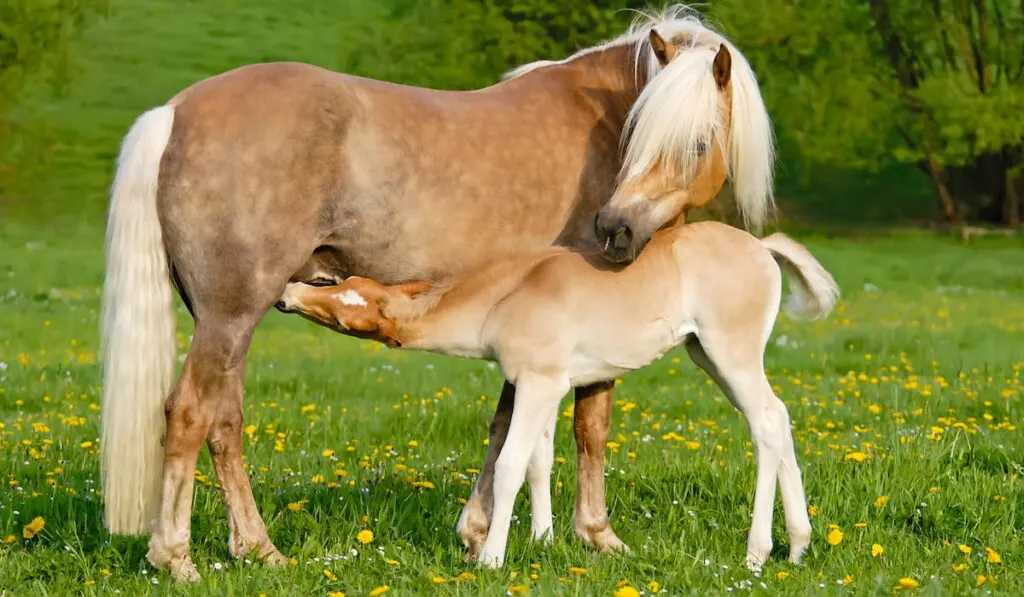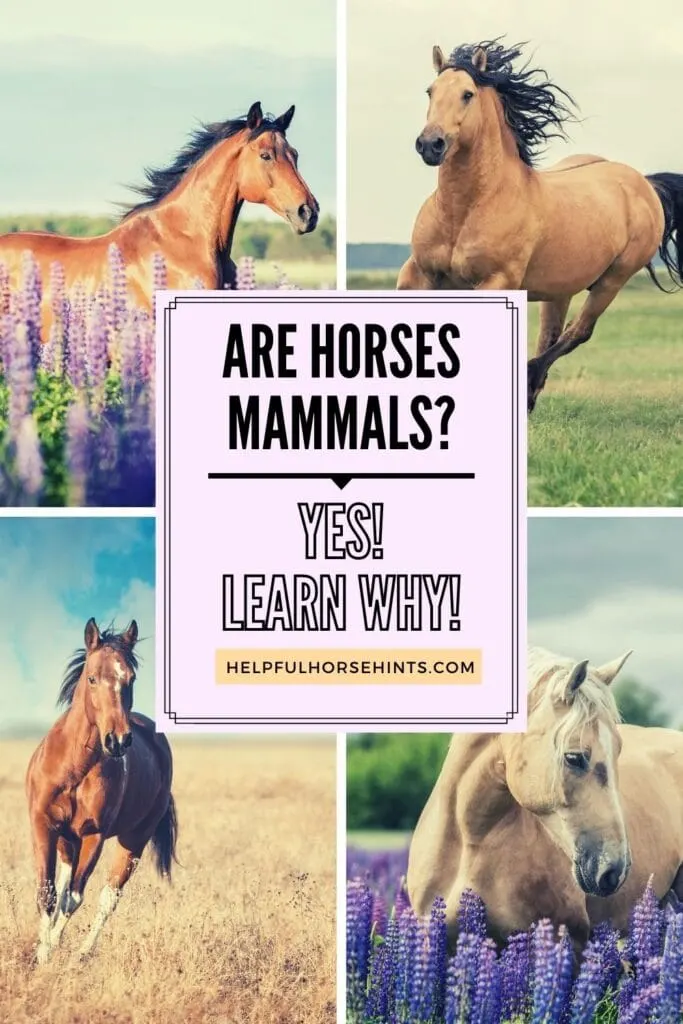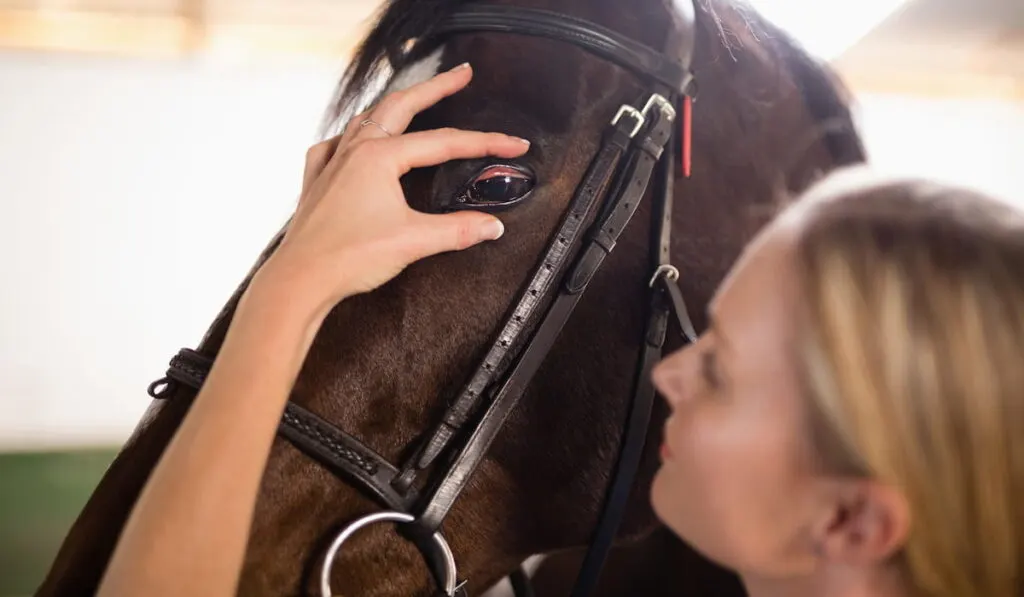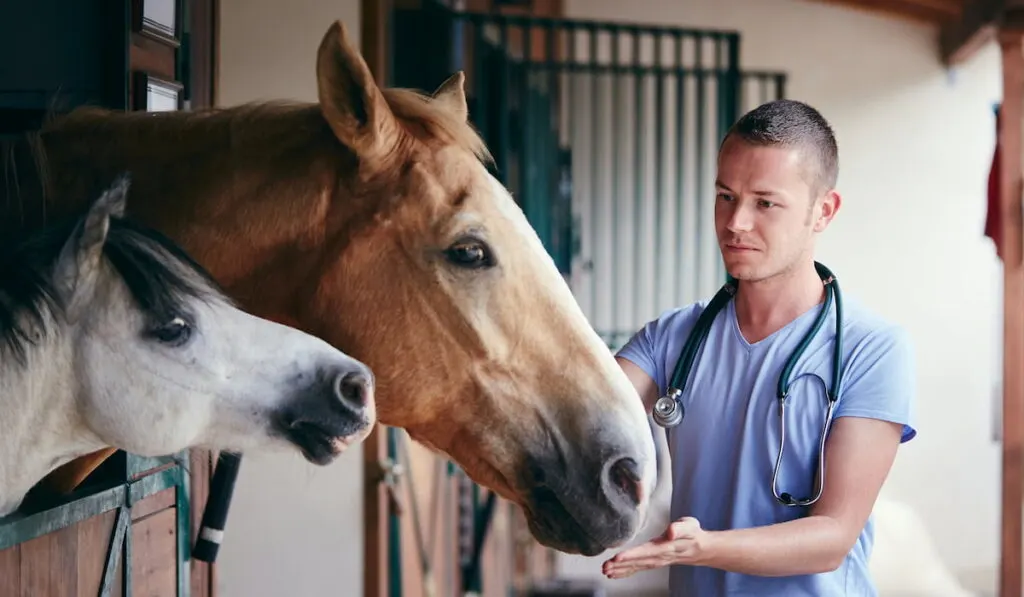Have you wondered if horses are mammals or not? Animals of all kinds fall into one of six categories, including birds, amphibians, reptiles, fish, mammals and invertebrates. Some horse breeds are referred to as cold-blooded or hot-blooded, and since mammals are all warm-blooded, this may cause some confusion!
Are Horses Mammals? The answer is a resounding yes! Horses – all horses – are considered mammals. Mammals are characterized by their ability to nurse offspring, and by their hair, vertebrae, and middle ear bone structure. Horses, even their prehistoric ancestors, are members of the mammal family.
Like many farm animals, horses possess all the major attributes that place them into the mammal category. Mammals are truly remarkable animals and they are able to do extraordinary things with their bodies. Horses are no exception. Read on to find out how our equine friends fit into the mammal world.

Table of Contents
What Are Mammals?
Mammals are a class of animals that share a variety of common characteristics, including the fact that they have mammary glands. The word mammal derives from the Latin word mamma which means “breast”.
Mammals create milk using their mammary glands and use it to feed their young. Thanks to this ability, mammals form unique bonds with their offspring that animals in other categories do not.
Along with mammary glands, mammals also have coats of fur or hair on their bodies, even though on some mammals – like elephants or dolphins – it’s almost invisible or it’s only whiskers. Mammals are all ‘warm-blooded’ animals that also have three bones in their middle ears which allow them to hear sound effectively. All mammals are also vertebrates, meaning that they have a backbone and spinal column.
Apart from these specific characteristics, mammals also tend to be very intelligent, are often capable of domestication and can communicate in unique and intricate ways. (source)

What Makes Horses Mammals?
Horses are mammals through and through. They have backbones which makes them vertebrates. Female horses also nurse their foals with milk they produce using their own mammary glands.
Horses also have coats comprised of hair that comes in a variety of beautiful colors and unique patterns. Their hair helps to keep them safe from outdoor elements including harsh rain, wind, and extreme temperatures. They are warm-blooded animals that are able to regulate their own internal temperature.
Horses have 3 middle ear bones called the hammer, anvil and stirrup. These bones make up the ossicles, one of the defining characteristics of mammals.
Horses are extremely intelligent and have long been domesticated by humans.
Mammal Domestication
In prehistoric times, most mammal animals served only as a food source for humans. Hunting animals, mainly mammals, was the one of the ways humans survived at the time.
Over time, humans began to domesticate mammals and use them for more than just food. They discovered that mammals, namely horses, could be domesticated and used to help with farming. Horses also provided a form of transportation that had not been available to humans before.
Humans also found that they could breed and raise mammals to eat without having to hunt them. This greatly changed the course of many humans lives and truly altered the course of history. The ability of many mammals to be domesticated helped to turn a hunting and often nomadic way of life into a more settled, agricultural lifestyle. (source)
Maternal Bonding In Horses
Being a mammal creates a unique bonding experience for animals, especially horses. The fact that mammals have mammary glands and personally feed their own young creates a maternal bond that begins at birth.
Maternal bonding is characteristic of most mammals.
While there are rare exceptions, most mares that give birth to a foal will quickly begin to bond with them. Horses, unlike some mammals, like to keep their babies very close and this begins immediately after they are born.
Shortly after birthing a foal, mares will instinctively begin to lick off the amniotic fluid that covers their baby. The mare will continue to lick, nuzzle and help push their baby to stand up and nurse. All of these actions help the mare quickly learn to distinguish their foal from other foals that look like them.
For the foals, it will take up to a week for them to be able to pick their mom out from a herd of horses, but thankfully their moms will be able to find them quickly, even if they get away from them. This bonding helps to ensure that the foal will continue to have a source of food and protection throughout their young lives. (source)
Horses Have the Largest Eyes of all Land Mammals

It is easy to see that horses have the largest eyes out of all the mammals that live on land. The equine eye is intriguing and performs a variety of functions.
Horses’ eyes must be able to function effectively throughout the day and the night because technically horses are animals of prey. They do not eat other animals, but predators can hunt them on occasion.
The horse’s large eyes sit on each side of their head, creating only a couple blind spots but also allowing them to see more of what is around them. Horses can recognize very slight movements that can cause some horses to spook more easily by nature from this defense mechanism.
Horses are able to see color, but not in the same way that humans can. They see color in 2 wavelength regions instead the 3 that humans can see. They are unable to recognize the color red. (source)
Why Are Draft Horses Called Cold-bloods If Mammals Are Warm-blooded?
All mammals are warm-blooded animals, which means that they are able to regulate their body temperature internally. This means that all horses are warm-blooded.
Often, however, equestrians refer to certain breeds of horses as cold-bloods, hot-bloods, or warm-bloods. These terms are used to describe their temperament, not their physiological design.
Draft horses are most often called cold-bloods due to their calm demeanor and easy-going personalities. These breeds include Clydesdales and Belgians, among others.
Some racing and competition horse breeds including Arabians and Thoroughbreds can be referred to as hot-bloods.
“Warmbloods” for horses refers to specific breeds that were created by crossing hot-blooded breeds with cold-blooded breeds. Dutch Warmbloods and Holsteiner horses fall into this category.
Warmblood horses have athleticism and a trainable temperament, and are highly sought after for eventing and as show horses. (source)
Only Mammals Can Get Rabies

Did you know that only mammals are able to get rabies? Animals in other categories like fish, reptiles, birds and even amphibians do not get rabies.
The rabies virus can only survive in warm-blooded animals. This means that as a mammals, horses can get the rabies virus. Horses can get infected from the bites of cats, raccoons, foxes, coyotes, and more.
Rabies is a frequently fatal disease that rapidly spreads to the animal’s brain and causes damage that cannot be repaired. Thankfully, there are annual vaccines available to keep our domesticated animals, including horses, safe.
Final Thoughts
Horses have always been and will always be members of the mammal family. Regardless of whether some horse breeds are referred to as cold-blooded or hot blooded, they are all warm-blooded mammals. Horses are unique, but they are still grouped into the larger category of mammals thanks to their backbones, mammary glands, temperature regulation, bonding capabilities, middle ear design and their coats of hair.
Source
- https://www.avma.org/public/Health/Pages/rabies.aspx

